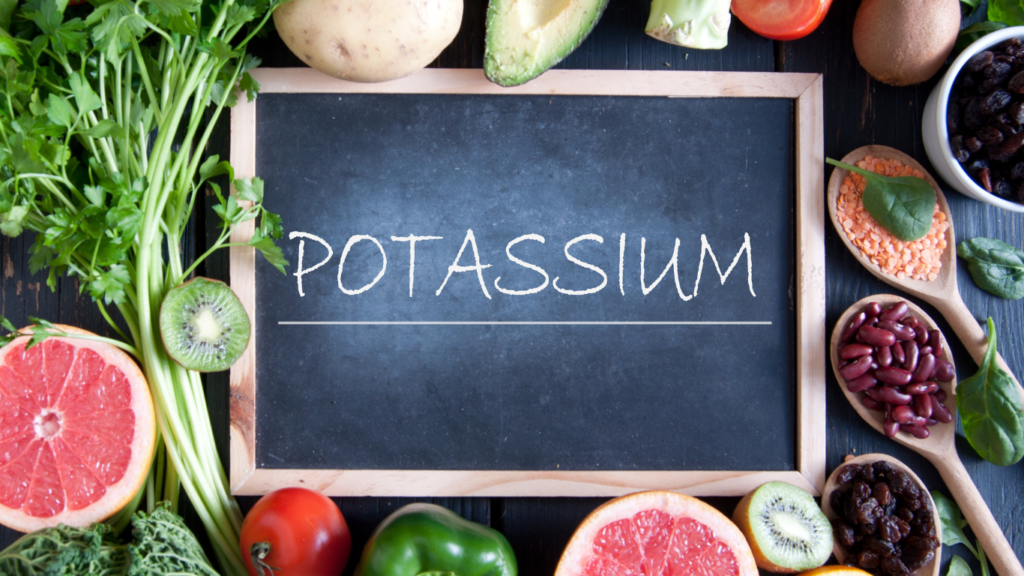35 Potassium Rich Foods. Health Benefits of Potassium
Potassium Rich Foods have several health benefits. Potassium is an essential component of numerous bodily functions. Although bananas are a well-known source of potassium, many other foods provide the same amount, if not more.
Potassium is an electrolyte that aids in the body's fluid and blood level equilibrium. It is also found in meat, milk, yogurt, and nuts.
A potassium-rich diet that is low in sodium — and electrolytes found in table salt and processed foods — can lower blood pressure and lessen the risk of heart disease and stroke.

Potassium-Rich Foods:
- Bananas:
Bananas contain potassium, which is beneficial to your heart health and blood pressure. A medium-sized banana has around 320-400 mg of potassium, which accounts for about 10% of your daily potassium requirements.
2. Potatoes:
Potatoes are high-potassium food. Baked potatoes with the skin on them are the best option since the skin contains the majority of the potassium in a potato.
The potassium content of a medium-cooked potato with skin is 941 mg. A person can avoid additional sodium by eating a baked potato with salt-free seasoning.
French fries are often low in nutrients and high in fat from the frying process, making them a less healthy alternative. Fries also have a high salt content, which might negate the advantages of potassium.
3. Oranges:
Oranges are high in potassium. Potassium supplementation can lower blood pressure in those who already have high levels and may lower your risk of heart disease.
1 medium-sized potassium contains approximately 240 milligrams of potassium.
4. Dried Apricots:
Potassium is abundant in a variety of dried fruits. Apricots are brilliant orange fruit that may be eaten fresh or dried.
The potassium content of half a cup of dried apricots is 1,101 mg. These fruits also include important minerals like iron and antioxidants.
When shopping for dried apricots, seek those that have no added sugar. Dried apricots can be eaten as a snack or added to salads or major dishes.
5. cantaloupe:
One medium-sized cantaloupe slice contains 4% of your daily potassium need. Potassium is a mineral that is required as an electrolyte. Potassium aids in the maintenance of proper water balance between cells and bodily fluids.
Grapefruits are slightly acidic and tangy, but they also have a sweet flavor, making them one of the most popular citrus fruits. Grapefruits are high in vitamins A and C, as well as being low in calories and fat, making them a beneficial addition to your diet. While grapefruits do not contain a large amount of potassium, they do provide a tiny portion of what you require each day.
7. Honeydew:
Because honeydew melon is low in sodium and high in potassium, it may help you maintain a healthy blood pressure level. If you want to improve your potassium consumption, try including honeydew in your diet. It's high in potassium, with a 1-cup (177-gram) serving to provide 13% of the RDI.
8. Sweet Potatoes:
These are orange in color and have a sweeter flavor than white potatoes. Because of their orange hue, they contain more beta carotene than regular potatoes, but they also contain potassium.
542 mg of potassium may be found in a cooked sweet potato with the skin still on.
A person should eat cooked or microwaved sweet potatoes with no added sugar for the healthiest option. It is also advisable to avoid canned sweet potatoes that have been packed in syrup.
9. Cucumbers:
One hundred grams of fresh cucumber has 147 milligrams of potassium. Potassium aids in the regulation of blood pressure and electrolyte balance in the body.
10. Avocado:
Avocado is a buttery fruit rich in nutrients such as heart-healthy monounsaturated fat and vitamins C, E, and K. Half a cup of avocados also contains almost 5 grams of fiber.
Avocados are high in potassium, with a half-cup serving containing 364 mg.
Avocados can be eaten fresh in salads, as dips, or on toast. They also work well in prepared foods like spaghetti.
11. Raisins:
Raisins are another potassium-rich dried fruit. Raisins are a popular snack.
A half-cup of raisins has 618 milligrams of potassium.
Choose raisins that include simply dried grapes and no additional sugar, coatings, or other additives for the healthiest option.
12. Milk:
Dairy products, such as milk and yogurt, are commonly thought to be high in calcium. Some dairy products, on the other hand, are an excellent source of potassium.
Milk has the highest potassium content among adults. A cup of 1% milk has 366 mg.
Tea and coffee are additional popular sources of potassium. An 8-ounce (oz) cup of brewed black coffee has 116 mg of potassiumTrusted Source, making it a low potassium food, however, adding creamers and milk significantly boosts the potassium level.
Other Foods that have a high amount of potassium include:
13. Yogurt:
A cup of plain nonfat yogurt offers up to 579 mg of calcium.
14. Kidney Beans:
A cup of canned kidney beans has 607 mg of potassium in it.
15. Navy Beans:
A cup of canned navy beans has 708 mg of potassium in it.
16. Refried Beans:
A cup of canned refried beans has 760 mg of potassium in it.
17. Black Beans:
A cup of canned black beans has 802 mg of potassium in it.
18. Lima Beans:
A cup of canned lima beans has about 950 mg of potassium.
19. White Beans:
1200 mg of potassium is found in 1 cup of canned white beans.
20. Adzuki Beans:
A cup of canned kidney beans has 1230 mg of potassium in it.
21. Peas:
A cup of peas contains about 350 milligrams of potassium.
22. carrot juice:
A cup of carrot juice has almost 690 mg of potassium.
23. Pomegranate Juice:
Pomegranate juice provides almost 540 milligrams of potassium per cup.
24. orange juice:
A cup of orange juice contains almost 500 milligrams of potassium.
25. tangerine juice:
One cup of tangerine juice contains almost 450 mg of potassium.
26. vegetable juice:
A cup of canned vegetable juice contains almost 470 mg of potassium.
27. passion fruit juice:
One cup of passion fruit juice has about 700 mg of potassium.
28. Tomato juice:
A cup of tomato juice contains almost 1050 mg of potassium.
29. Atlantic Fish:
A 3-ounce meal of Atlantic salmon provides almost 540 milligrams of potassium.
30. Mackerel:
A 3-ounce plate of Mackerel provides about 480 mg of potassium.
31. Snapper:
A 3-oz serving of Snapper provides almost 450 mg of potassium.
32. Rainbow Trout:
A 3-oz serving of Rainbow Trout has about 380 mg of potassium.
33. Halibut:
A 3-ounce portion of Halibut provides almost 450 mg of potassium.
34. Mushrooms:
One cup of sliced mushrooms has almost 230 milligrams of potassium.
35. Cooked Broccoli:
One cup of cooked broccoli has almost 470 milligrams of potassium.
Potassium Daily Intake:
Potassium is a mineral that is necessary for the proper functioning of your heart, kidneys, muscles, and nerves. Low potassium levels can elevate blood pressure, increase the risk of kidney stones, and even draw calcium from your bones.
Diets high in potassium-rich-diet and low in salt may reduce the risk of hypertension and stroke.
Despite its significance, many people do not consume as much potassium as they need. It has been designated as a "nutrient of public health concern" in the Dietary Guidelines for Americans.
How much potassium do you need? Taylor recommends a daily intake of 2,600 mg for women and 3,400 milligrams for males. Previously, the National Academies of Sciences, Engineering, and Medicine suggested 4,700 milligrams per day, but the amount was changed in 2019 by the National Academies of Sciences, Engineering, and Medicine. So obtaining your daily potassium dose is now even easier.
Potassium Benefits for Health: Health Benefits
Bone and muscle preservation: Benefits of Potassium Rich Foods
Potassium may be advantageous to the health of your bones. People who eat a lot of potassium-rich fruits and vegetables may have higher bone mineral density than the average person. A potassium-rich diet may also be beneficial in the maintenance of muscle mass in the elderly and those suffering from muscle-wasting illnesses, according to research. Muscle cramping should be avoided at all costs.
Perspiration depletes electrolytes, including potassium and sodium, which must be replenished in order to maintain a high level of activity. However, it appears that adequate amounts of potassium and sodium before, during, and after exercise are the most important factors in avoiding muscle cramping.
Cardiovascular health and Blood pressure: Benefits of Potassium Rich Foods
A sufficient potassium intake may help to avoid or control high blood pressure. A high potassium intake combined with a reduced-sodium consumption may help lower the risk of cardiovascular disease and stroke.
Regulates Fluid Balance: of Potassium Rich Foods
The body is composed of roughly 60% water. 40% of this water is present inside your cells in the form of intracellular fluid (ICF).
The rest is located outside of your cells in places like your blood, spinal fluid, and between cells, known as ECF.
Surprisingly, the concentration of electrolytes, particularly potassium and sodium, affect the quantity of water in the ICF and ECF.
The primary electrolyte in the ICF is potassium, which regulates the quantity of water inside the cells. Sodium, on the other hand, is the primary electrolyte in the ECF, and it regulates the quantity of water outside the cells. Osmolality is defined as the number of electrolytes concerning the amount of fluid. Under normal circumstances, the osmolality inside and outside your cells is the same.
Simply explained, your cells have an equal mix of electrolytes on the exterior and inside.
When osmolality is uneven, water will flow from the side with fewer electrolytes toward the side with more electrolytes to balance electrolyte concentrations.
As a result, cells may shrink as water travels out of them or expand and rupture as water rushes in. That is why it is critical to ingest the proper electrolytes, especially potassium.
Maintaining a healthy fluid balance is essential for optimum health. Dehydration can result from a lack of fluid balance, which affects the heart and kidneys. Eating a potassium diet and staying hydrated will help you keep your fluid balance in check.
Kidney Stones:
The presence of abnormally high levels of calcium in the urine (hypercalciuria) increases the likelihood of kidney stone development. Diets high in protein and poor in potassium may increase the likelihood of stone development.
The nervous system's function is to transmit messages between your brain and the rest of your body.
They are sent as nerve impulses and are responsible for the regulation of muscle contractions, heartbeat, reflexes, and a range of other physiological functions.
In neurons, sodium ions flow into cells and potassium ions flow out of cells, causing nerve impulses to be generated. The flow of ions causes an alteration in the voltage of the cell, which results in the start of a neuronal signal.
Unfortunately, a decrease in potassium levels in the blood may impede the body's ability to generate a nerve impulse, which is a serious problem. Getting adequate potassium in your diet may aid in the maintenance of normal nerve function.
Potassium counteracts the effects of sodium:
The most important function of potassium is to regulate sodium levels in the body, allowing the body to function properly. "An adequate potassium to sodium ratio is required for electrolyte balance, which is required for healthy muscle contraction and nerve transmission, fluid balance, which supports normal blood pressure levels, and acid-base balance, which is essential for bone strength preservation," says the National Institutes of Health's National Institute of Nutrition. In order for the body to maintain appropriate fluid and blood levels, potassium and sodium must be consumed in sufficient proportions; hence, it is important to ingest adequate amounts of both. In contrast, if you drink an excessive amount of sodium and insufficient potassium, your blood pressure may increase to dangerously high levels, which is hazardous to your heart.



